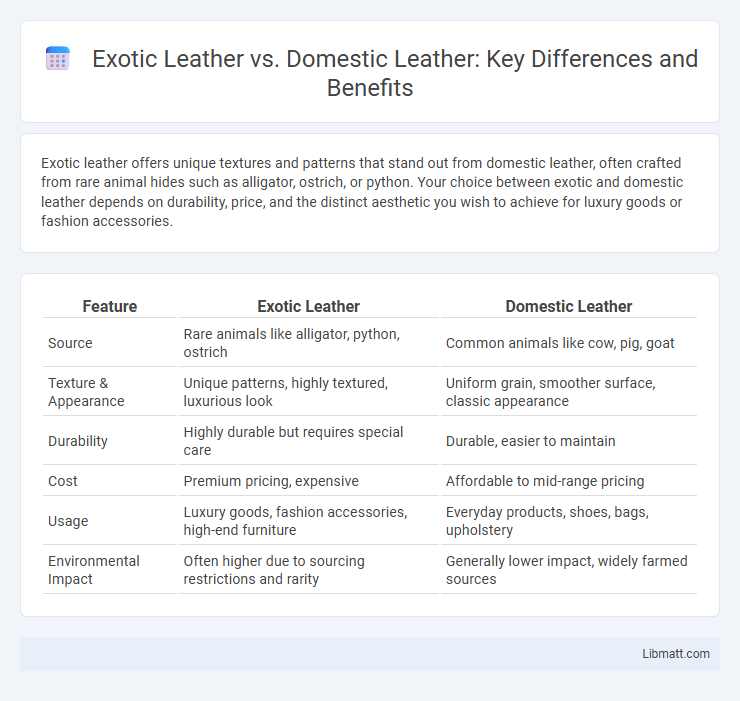Exotic leather offers unique textures and patterns that stand out from domestic leather, often crafted from rare animal hides such as alligator, ostrich, or python. Your choice between exotic and domestic leather depends on durability, price, and the distinct aesthetic you wish to achieve for luxury goods or fashion accessories.
Table of Comparison
| Feature | Exotic Leather | Domestic Leather |
|---|---|---|
| Source | Rare animals like alligator, python, ostrich | Common animals like cow, pig, goat |
| Texture & Appearance | Unique patterns, highly textured, luxurious look | Uniform grain, smoother surface, classic appearance |
| Durability | Highly durable but requires special care | Durable, easier to maintain |
| Cost | Premium pricing, expensive | Affordable to mid-range pricing |
| Usage | Luxury goods, fashion accessories, high-end furniture | Everyday products, shoes, bags, upholstery |
| Environmental Impact | Often higher due to sourcing restrictions and rarity | Generally lower impact, widely farmed sources |
Introduction to Exotic and Domestic Leathers
Exotic leather originates from non-traditional animals such as snakes, alligators, or ostriches, offering unique textures, patterns, and high durability that make it a luxury choice in fashion and accessories. Domestic leather, mainly sourced from cows and pigs, is widely available, versatile, and often more affordable, making it a practical option for everyday use. Understanding the distinct properties of exotic vs domestic leather can help you select materials that align with your style preferences and functional needs.
Defining Exotic Leather: Types and Sources
Exotic leather includes materials sourced from unique animals such as alligators, snakes, ostriches, and stingrays, offering distinct textures and patterns unavailable in domestic leather. These leathers are prized for their rarity, durability, and luxury appeal, often sourced from tropical or specialized regions rather than common livestock farms. Understanding the types and origins of exotic leather helps you make informed decisions about quality and ethical considerations in luxury leather goods.
Popular Domestic Leathers Explained
Popular domestic leathers such as cowhide, sheepskin, and pigskin offer durability and versatility, making them ideal for everyday use in furniture, apparel, and accessories. Cowhide is prized for its toughness and ability to develop a rich patina, while sheepskin provides softness and breathability, often used in luxury clothing and lined footwear. Your choice between exotic and domestic leather should consider the practicality of domestic options, which generally offer lower maintenance and greater availability without compromising quality.
Unique Characteristics of Exotic Leather
Exotic leather, sourced from rare animals such as alligators, ostriches, and snakes, showcases distinctive textures and patterns that set it apart from domestic leather. Its durability often surpasses that of traditional cowhide, offering enhanced strength and flexibility tailored to luxury fashion and accessories. You benefit from owning products with exclusive aesthetics and long-lasting quality unique to exotic leather.
Durability and Longevity: Exotic vs Domestic
Exotic leather, sourced from animals like alligators, snakes, or ostriches, typically offers superior durability and longevity due to its dense fiber structure and natural resistance to wear. Domestic leather, often made from cowhide or sheepskin, provides reliable strength but usually ages faster and shows signs of wear sooner without proper care. You benefit from investing in exotic leather for products demanding long-term resilience and distinctive texture.
Ethical and Environmental Considerations
Exotic leather, sourced from rare animals like alligators or snakes, often raises ethical concerns due to endangered species protections and animal welfare issues, while domestic leather, typically derived from cows, tends to follow more regulated farming and slaughter practices. Environmentally, exotic leather production can contribute to biodiversity loss and habitat destruction, whereas domestic leather is increasingly scrutinized for its high water usage, greenhouse gas emissions, and impact of livestock farming. Sustainable alternatives and certifications are emerging to address the environmental footprint and ethical implications in both exotic and domestic leather industries.
Cost Comparison: Exotic Leather vs Domestic Leather
Exotic leather, sourced from animals like crocodiles, ostriches, and snakes, typically commands higher prices due to rarity, labor-intensive processing, and stringent regulations. Domestic leather, derived from cows or pigs, generally offers a more affordable option with consistent availability and simpler manufacturing processes. Price differences are significant, with exotic leather products often costing two to five times more than their domestic counterparts, reflecting the exclusivity and craftsmanship involved.
Fashion and Design Applications
Exotic leather, derived from materials like crocodile, snake, and ostrich, offers unique textures and patterns that elevate high-fashion designs with a distinct luxury appeal. Domestic leather, typically sourced from cowhide or sheepskin, provides versatility and durability, making it ideal for everyday fashion and accessory applications. Your choice between exotic and domestic leather shapes the exclusivity and aesthetic statement of clothing, handbags, and footwear in the fashion industry.
Care and Maintenance Differences
Exotic leather, derived from animals like snakes, alligators, and ostriches, demands specialized care involving gentle cleaning with conditioner products specifically formulated for delicate or porous surfaces to maintain its texture and prevent cracking. Domestic leather, typically sourced from cows, is more resilient and can be maintained with regular cleaning, conditioning, and occasional waterproofing treatments using widely available leather care products. Proper storage in a cool, dry place away from direct sunlight is essential for both types, but exotic leather requires extra caution to avoid exposure to moisture and abrasive materials.
Making the Choice: Which Leather is Right for You?
Choosing between exotic leather and domestic leather depends on your preference for uniqueness and budget, as exotic leather like alligator or ostrich offers distinctive patterns and durability but comes at a higher price. Domestic leather, typically sourced from cows, provides reliable quality and versatility at a more affordable cost, suitable for everyday use. Assess your style needs and maintenance capacity to determine which leather material aligns best with your personal requirements.
Exotic leather vs domestic leather Infographic

 libmatt.com
libmatt.com